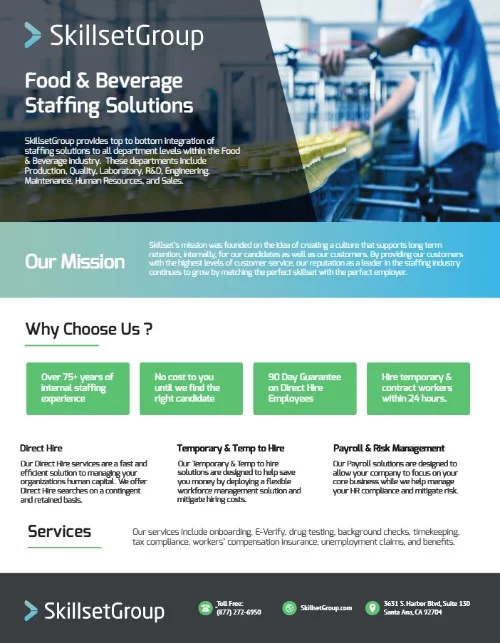Extended unemployment benefits throughout the U.S. have businesses and staffing companies struggling to find employees for lower-wage jobs.
In many cases, decades of depressed wages have created a situation in which the generous unemployment benefits instituted in response to COVID-19 lockdowns are more lucrative than taking an entry-level job. Unemployment benefits paid more than wages for about half the people receiving them through spring of 2021, according to the Peterson Institute for International Economics.
This has put pressure on employers to raise wages, increasing labor costs in a market in which prices of materials and other inputs are also skyrocketing.

In the past, extensions in unemployment insurance benefits have had little effect on wages or employees’ labor force participation, but this late-stage-pandemic time is a unique situation. Worker fears of coronavirus exposure factor into their employment decisions, and many older workers took the pandemic lockdowns or layoffs as a cue to retire, among other factors.
Do Extended Unemployment Insurance Benefits Keep People from Taking Jobs?
According to research on extended benefits instituted during the 2008 housing market crash and resulting financial crisis, the benefit extensions reached 99 weeks for most people, and Congress didn’t roll them back until 2013. These extended benefits barely budged labor force participation.
“We find little or no effect on job-finding but a reduction in labor force exits due to benefit availability,” states a 2015 economic analysis by the Federal Reserve Bank of San Francisco. “We estimate that the rollbacks reduced the labor force participation rate by about 0.1 percentage point in early 2014.”
The effects of the current generous UI extensions, meant to help families staying home from work to save lives from the deadly 2020 coronavirus pandemic, seem to be more profound, however.
It’s too early to see the total effect of current UI policy in published data. From the view of a staffing professional in Southern California, however; the results are clear.
Staffing agencies and firms all over the country are having a tough time filling positions, in many cases because of the extended UI benefits.
Why Is the Current Labor Market So Challenging?

According to the Brookings Institution, labor force participation rates are highest in states with the highest ratio of vaccinated individuals, suggesting that extended UI benefits are only part of the story of the current labor shortage.
It’s no surprise that people are leaning on UI to stay out of the labor force in summer of 2021; keeping people home was one of the stated purposes of the UI extensions when Congress approved them in the first place.
“If you’re going to ask people to do that, to ask businesses to close, and ask people to stay home and close schools, then there ought to be something very generous on the other side,” said Lauren Bauer, Economic Studies Fellow with the Hamilton Project, on a Brookings podcast. “And that’s certainly how unemployment insurance has functioned over the past year.”
An economic analysis published in early May by the Peterson Institute for International Economics cited extended UI benefits as keeping people from taking the approximately 10 million jobs available this spring.
“Increased unemployment insurance has resulted in unemployment benefits being more valuable than wages for roughly half of the unemployed” according to the Peterson Institute. “This does not appear to have been a major factor in the labor market in 2020, but labor market conditions are completely different now. There is no clear evidence yet, but historical experience, theory, and commonsense all suggest it is one factor in labor supply—including giving people who feel unsafe returning to work more options.”
Indeed, workers don’t seem too worried about their job options. In February of 2021, more US residents (2.3 percent) quit their jobs than at any other time since the Bureau of Labor Statistics started counting in 2001.
And it seems workers who quit were right not to worry – the number of open jobs has exploded throughout the spring and early summer.
Does a Lack of Childcare Keep Parents of Young Children Out of the Labor Force?
Economists theorized early in the pandemic that parents of young children would be so burdened by the lockdowns of the school systems throughout the U.S. they would drop out of the labor force.
This does not seem to be the case, however. Even through 2020, employment rates for parents of young children didn’t fall significantly compared with other demographics.
When Will the Labor Market Get Back to Normal?
The pandemic-related upheaval of the global economy makes it tricky to figure out when the labor market will get back to “normal,” if it was ever accurate to call such a huge set of variables “normal.”
“Normal” for sectors like engineering, information technology and skilled manufacturing trades means there were already labor shortages before the pandemic. Furthermore, vaccination rates are rising, but so are infection rates of the coronavirus’ highly contagious Delta variant. This clouds the crystal ball.
What we can say for sure is, barring another Congressional extension, the additional weeks of Federal UI benefits will expire Sept. 6. People who lose their jobs after that date will be back to the standard 26 weeks of benefits from their regular state UI programs, according to the Center on Budget Policy and Priorities.
Under the CARES Act in response to the pandemic, all states added 13 additional weeks to UI benefits using federal funds. In addition, many who lost jobs and normally wouldn’t qualify for UI received assistance from the Pandemic Emergency Unemployment Assistance program.
One thing seems certain, however; employers may be stuck with higher labor costs for lower wage workers for the foreseeable future.
“Like wage growth pre-pandemic, the strongest wage growth … has been for the bottom quartiles of workers (higher state and local minimum wages have contributed to this fact),” states the Peterson Institute. “Overall, if the only data we had about the economy came from wages, one would be hard pressed to know that labor markets were any looser than they were in 2019, despite employment remaining 10 million below trend.”

In the coming months, Peterson predicts an increase in both labor supply and labor demand. Whether those laborers’ skillsets are matched to that demand will determine how quickly employment rates return to something like the pre-pandemic market.
"The Effect of Extended Unemployment Insurance Benefits: Evidence from the 2012-2013 Phase-Out"
Henry S. Farber et al
Working Paper Series
U.S. Federal Reserve Bank of San Francisco
January 2015
“Policy Basics: How Many Weeks of Unemployment Compensation Are Available?”
Center for Budget and Policy Priorities
June 2021
“Examining the uneven and hard-to-predict labor market recovery”
Lauren Bauer et al
The Brookings Institution
June 2021
“Congress extended unemployment benefits. What should come next?”
The Current Podcast
The Brookings Institution
March 2021
“The US labor market is running hot…or not?”
Jason Furman et al
The Peterson Institute for International Economics
May 2021

